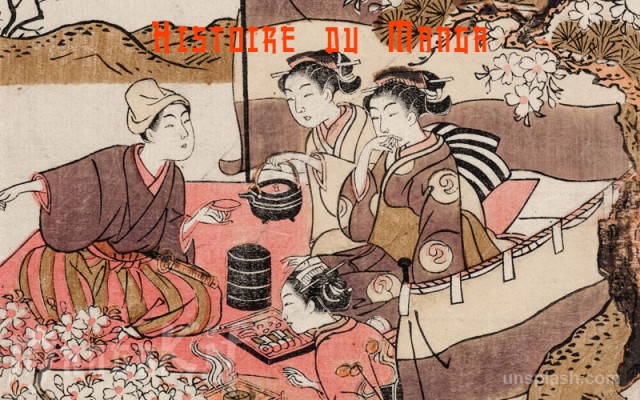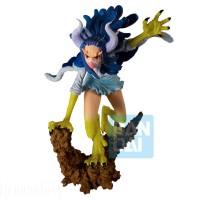History of Manga: From its Origins to Today
In the bustling universe of narrative art, manga has carved out a special place for itself, evolving from its humble beginnings to become an international cultural phenomenon. Our article today delves into the heart of this distinctive art form, exploring its evolution, transformations, and indelible impact on the global artistic landscape. Discover how, from its initial sketches during the Edo era to its contemporary digital boom, manga has managed to captivate the imaginations of millions, transcend linguistic and cultural barriers, and establish itself as a powerful means of expression. Join MangaKif on an illustrated journey through the ages, where tradition and innovation combine to narrate the fascinating history of manga, a mirror of the society that saw its birth and a reflection of the universality of the stories it depicts.

Introduction
The term “manga” encompasses a variety of genres and styles, essentially defining comics and animated drawings originating from Japan. The word itself literally means “whimsical pictures” or “spontaneous drawings”, highlighting the both serious and playful nature of this art. Mangas are characterized by their rich narratives, detailed and expressive drawings, and their ability to address a multitude of subjects, from the most frivolous to the most profound.
Steeped in ancestral tradition and fueled by unceasing innovation, mangas are a central pillar of Japanese popular culture. Its origins date back to the Edo period, where the first forms of visual narratives began to appear. However, it was truly in the post-war era, with artists like Osamu Tezuka, that modern manga took flight.
In this article, we invite you to explore the rich and varied trajectory of manga, from its modest beginnings to its current status as a global phenomenon.
1. The Early Forms of Manga
Exploring the roots of manga inevitably takes us back to the flourishing Edo period, where the art of illustrated storytelling began to shape what we know today as manga. This fascinating period indeed reveals the very first illustrations, demonstrates the influence of ukiyo-e prints, and marks the appearance of illustrated narratives.
1.1. The Edo Era and the First Illustrations
The Edo era, extending from 1603 to 1868, marks a crucial moment in the cultural history of Japan, and it is in this context that the precursors of manga are born. These first illustrations, characterized by expressive lines and simple yet captivating narratives, laid the foundations of an art that would captivate the world. Everyday life, myths, and popular stories were all subjects that inspired these embryonic works.
1.2. Influence of Ukiyo-e Prints
Ukiyo-e, a Japanese term literally meaning “pictures of the floating world”, is a form of Japanese art of the time that deeply influenced the evolution of manga. These colorful prints, often depicting landscapes, scenes of everyday life, and portraits, introduced stylistic and narrative elements that would become central in the design of manga. The juxtaposition of images and the capture of movement are legacies of ukiyo-e that continue to shape contemporary manga.
1.3. Emergence of Illustrated Narratives
With the evolution of art and printing, the Edo era also saw the appearance of the first illustrated narratives, a direct precursor to modern manga. These narratives, combining images and text, allowed for a deeper immersion into the story and offered a new way to explore various themes. They paved the way for the explosion of narrative diversity and complexity that manga would subsequently experience.
2. Modern Manga and the Post-War Era
The post-war era was a decisive turning point in the history of manga. It paved the way for the transformation of this art form into a full-fledged cultural phenomenon. During this time, the manga landscape was profoundly shaped by the influence of American occupation, the emergence of pioneering figures like Osamu Tezuka, the blossoming of various genres, and the creation of dedicated magazines.
2.1. Influence of American Occupation
During the American occupation in Japan, from 1945 to 1952, many Western influences permeated Japanese culture, including manga. American comics, brought by the allied forces, introduced new styles and themes and encouraged more freedom of expression in manga, thus reflecting the changes of the times.
2.2. Birth of Modern Manga with Osamu Tezuka
Osamu Tezuka, often dubbed the "God of Manga", played a key role during this period of change. Inspired by Western cartoons and comics, Tezuka revolutionized manga by using new techniques and creating more complex stories. His major success, "Astro Boy", marked the beginning of modern manga and laid the foundation for a new golden age of this narrative art.
2.3. Development of Diverse Styles and Genres
Tezuka’s innovation led to an unprecedented diversification of manga genres and styles. From science fiction to historical narratives, through romances and dramas, manga began exploring a multitude of themes and reaching an increasingly broad and diverse audience. This narrative richness allowed manga to evolve and adapt to the changing tastes of readers.
2.4. Creation of Manga Magazines
The emergence of manga magazines played a supremely important role in the popularization of this art. These magazines featured a plethora of series for all ages and helped artists gain numerous fans. The competition between magazines also spurred more creativity and innovation, making manga a significant part of Japanese pop culture.
3. Manga’s Expansion in the 80s and 90s
The 80s and 90s represented a golden era for manga, marking an incredible rise in popularity that transcended the borders of Japan. During these two decades, the manga industry experienced great successes. Iconic titles were born, and anime emerged as a means of popularizing manga worldwide.
3.1. Explosion of Popularity in Japan
During this period, manga became an essential element of Japanese culture, reaching all age groups and social classes. The diversification of genres and richness of themes attracted an increasingly large readership, making manga a mass phenomenon. This fervor is clearly reflected in the astronomical sales and proliferation of manga stores across Japan.
3.2. Major Successes and Their Impacts
The 80s and 90s saw the emergence of titles that would mark the history of manga and influence a whole generation of readers and creators. Works like "Dragon Ball", "Akira", and "Sailor Moon" became cultural icons, set new standards for the industry, and introduced manga internationally. All these successes reinforced manga’s place in pop culture and shaped its image abroad.
3.3. The Emergence of Anime and Its Role in Popularizing Manga
Alongside the success of manga, anime also experienced significant growth. Indeed, animated adaptations of successful mangas played a major role in spreading this art form outside of Japan. Animated series, accessible and appealing, became ambassadors for manga, attracting new fans and generating interest in the original works. Thus, anime and manga complemented and reinforced each other to shape a unique and distinctive visual culture.
4. Modern Manga in the Digital Age
The advent of the digital era has opened a new chapter for manga, completely transforming the way these works are created, shared, and read. The shift to digital, the emergence of online reading sites, and the influence of social media have played an essential role in modernizing and globalizing manga.
4.1. Transition to Digital Format
The digitization of manga represents a major turning point, making these works more accessible and convenient than ever. Mangas are now within easy reach, attracting new fans and making this art form even more available. This transition has also enabled a reduction in production and distribution costs, thus fostering the emergence of new artists and the diversification of available works.
4.2. Online Reading Platforms
With digitization, numerous online reading platforms have emerged, offering fans worldwide instant access to a vast collection of manga. These sites not only allow the discovery of classics but also exploration of the latest releases, contributing to the ongoing expansion of manga’s popularity and the creation of a global community of enthusiasts.
4.3. Impact of Social Media and Online Communities
Social media and online communities have significantly altered the way manga is consumed and appreciated. They provide a space for exchange, discussion, and sharing for fans, facilitating the formation of tight-knit communities and the rapid spread of trends. Moreover, artists use these platforms to connect with their fans, gather feedback, and even share their works, thereby bringing creators and consumers closer together.
5. Current Trends and the Future of Manga
Between tradition and ongoing innovation, manga today is a vibrant art form, exploring new domains and continually adapting its modes of expression. In this section, we will delve into the genres and themes currently in vogue, the new authors and artistic innovations shaping the face of contemporary manga, and finally, we will attempt to glimpse the future prospects and possible developments of this captivating medium.
5.1. Popular Genres and Themes
Today, manga encompasses all sorts of genres and themes, reflecting the aspirations, dreams, and concerns of contemporary society. From fantastical works to realistic narratives, current mangas offer a diverse range, allowing every reader to find something to their liking. The Isekai genre continues its ascent, while slice-of-life narratives and psychological dramas are also gaining popularity, showcasing the richness and versatility of the art of manga.
5.2. New Authors and Artistic Innovations
Manga's creative energy is constantly rejuvenated by the arrival of new authors, who bring fresh ideas, unique styles, and innovative perspectives. These new talents push artistic boundaries, experiment with narrative forms and drawing techniques, thereby enriching the world of manga. The current scene is a melting pot of innovation, where tradition and modernity meet and reinvent themselves.
5.3. Glimpse into the Future and Evolutions
As the future becomes increasingly digital and global, manga stands ready to embrace new changes and reach new horizons. Emerging technologies like augmented and virtual reality could create new ways of experiencing and immersing in the works. Additionally, the growing exchange between different cultures and art forms heralds creative fusion and increased diversity of works. The future of manga holds untapped possibilities, promising discoveries and inspirations for fans of this art form.
Conclusion
From its humble beginnings in the Edo era to its evolution in the digital age, manga has become an influential art form and a universal medium of expression. This pillar of Japanese culture, embodied by icons like Osamu Tezuka, has captivated readers worldwide, transcending borders and adapting to modernity. It reflects the diversity of human experience and social dynamics while establishing intercultural bridges and influencing various forms of art.
As manga continues to explore new creative frontiers while remaining true to its essence, the future promises even more discoveries and wonders for enthusiasts of this art form. In concluding this journey through the history of manga, we observe a living art, whose global cultural impact continues to grow, and for those eager to explore further, the online world abounds with manga treasures waiting to be discovered.

 Francais
Francais 

